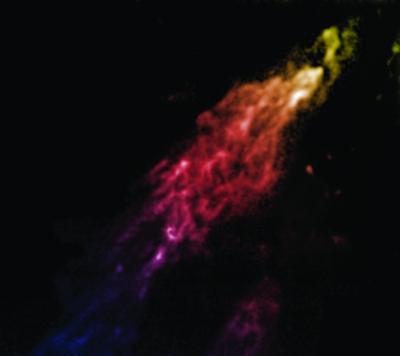Failed dwarf galaxy survives galactic collision thanks to full dark-matter jacket

This is a false-color image of the Smith Cloud made with data from the Green Bank Telescope (GBT). Credit: NRAO/AUI/NSF
If confirmed by further observations, a halo of dark matter could mean that the Smith Cloud is actually a failed dwarf galaxy, an object that has all the right stuff to form a true galaxy, just not enough to produce stars.
“The Smith Cloud is really one of a kind. It's fast, quite extensive, and close enough to study in detail,” said Matthew Nichols with the Sauverny Observatory in Switzerland and principal author on a paper accepted for publication in the Monthly Notices of the Royal Astronomical Society. “It's also a bit of a mystery; an object like this simply shouldn't survive a trip through the Milky Way, but all the evidence points to the fact that it did.”
Previous studies of the Smith Cloud revealed that it first passed through our Galaxy many millions of years ago. By reexamining and carefully modeling the cloud, astronomers now believe that the Smith Cloud contains and is actually wrapped in a substantial “halo” of dark matter — the gravitationally significant yet invisible stuff that makes up roughly 80 percent of all the matter in the Universe.
“Based on the currently predicted orbit, we show that a dark matter free cloud would be unlikely to survive this disk crossing,” observed Jay Lockman, an astronomer at the National Radio Astronomy Observatory in Green Bank, West Virginia, and one of the coauthors on the paper. “While a cloud with dark matter easily survives the passage and produces an object that looks like the Smith Cloud today.”
The Milky Way is swarmed by hundreds of high-velocity clouds, which are made up primarily of hydrogen gas that is too rarefied to form stars in any detectable amount. The only way to observe these objects, therefore, is with exquisitely sensitive radio telescopes like the GBT, which can detect the faint emission of neutral hydrogen. If it were visible with the naked eye, the Smith Cloud would cover almost as much sky as the constellation Orion.
Most high-velocity clouds share a common origin with the Milky Way, either as the leftover building blocks of galaxy formation or as clumps of material launched by supernovas in the disk of the Galaxy. A rare few, however, are interlopers from farther off in space with their own distinct pedigree. A halo of dark matter would strengthen the case for the Smith Cloud being one of these rare exceptions.
Currently, the Smith Cloud is about 8,000 light-years away from the disk of our Galaxy. It is moving toward the Milky Way at more than 150 miles per second and is predicted to impact again in approximately 30 million years.
“If confirmed to have dark matter this would in effect be a failed galaxy,” said Nichols. “Such a discovery would begin to show the lower limit of how small a galaxy could be.” The researchers believe this could also improve our understanding of the Milky Way's earliest star formation.
Media Contact
All latest news from the category: Physics and Astronomy
This area deals with the fundamental laws and building blocks of nature and how they interact, the properties and the behavior of matter, and research into space and time and their structures.
innovations-report provides in-depth reports and articles on subjects such as astrophysics, laser technologies, nuclear, quantum, particle and solid-state physics, nanotechnologies, planetary research and findings (Mars, Venus) and developments related to the Hubble Telescope.
Newest articles

Silicon Carbide Innovation Alliance to drive industrial-scale semiconductor work
Known for its ability to withstand extreme environments and high voltages, silicon carbide (SiC) is a semiconducting material made up of silicon and carbon atoms arranged into crystals that is…

New SPECT/CT technique shows impressive biomarker identification
…offers increased access for prostate cancer patients. A novel SPECT/CT acquisition method can accurately detect radiopharmaceutical biodistribution in a convenient manner for prostate cancer patients, opening the door for more…

How 3D printers can give robots a soft touch
Soft skin coverings and touch sensors have emerged as a promising feature for robots that are both safer and more intuitive for human interaction, but they are expensive and difficult…





















